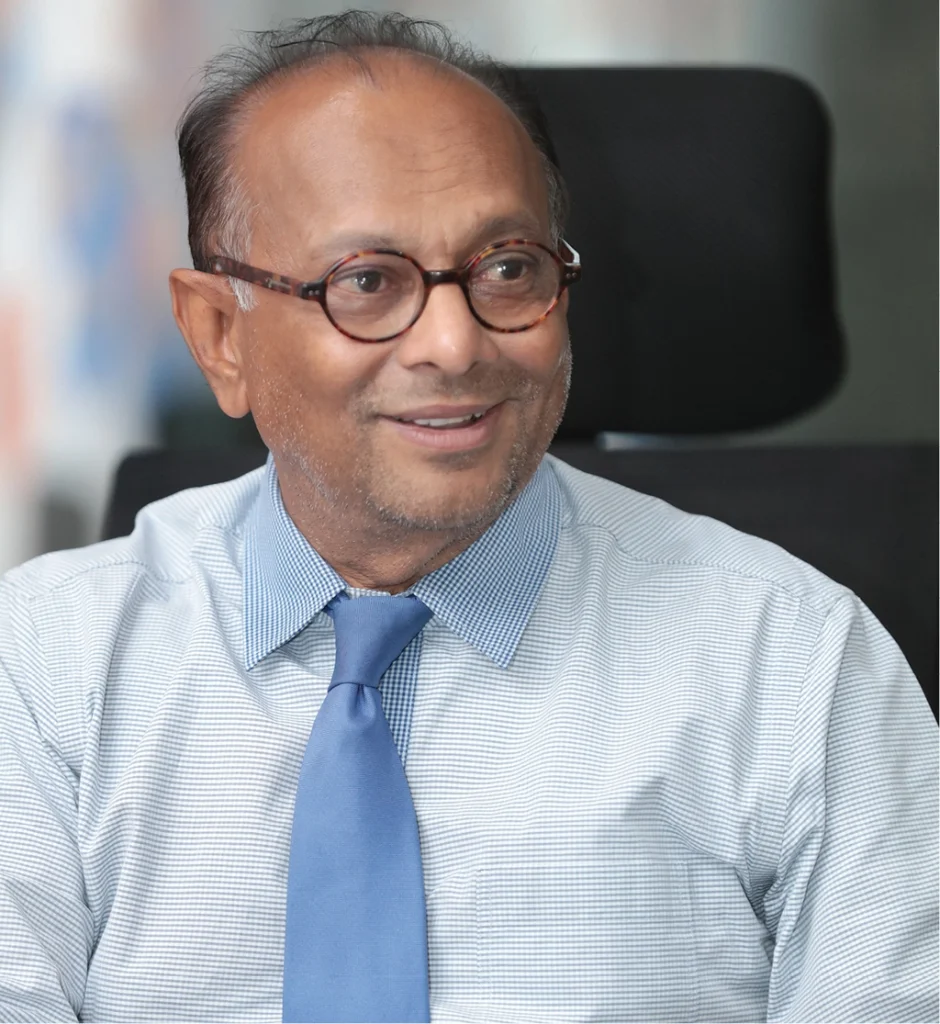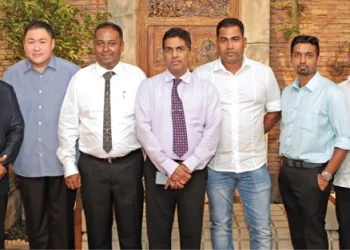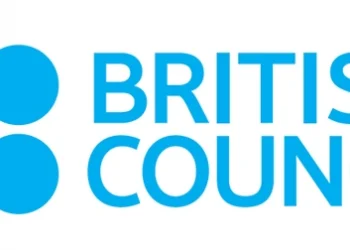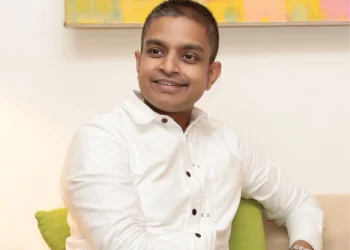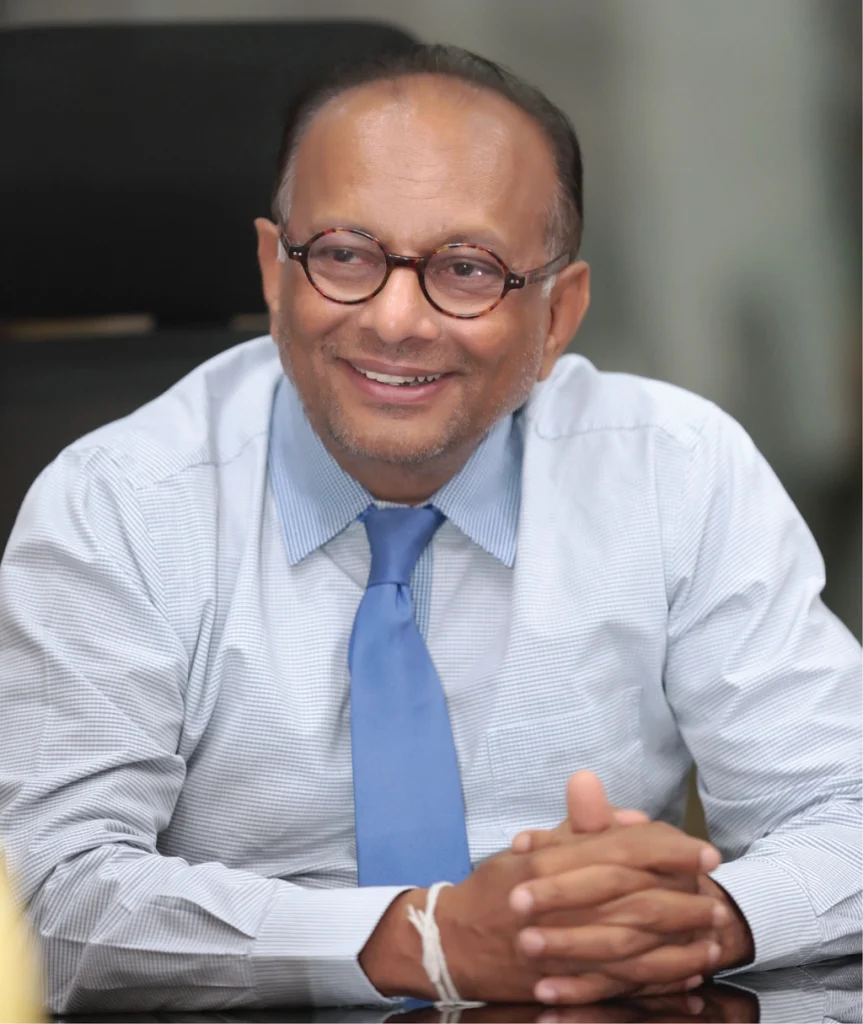
Introducing an eco-cultural tourism concept that embraces the Sri Lankan identity, Chandra Wickramasinghe, Founder, Chairman/Managing Director, Connaissance de Ceylan and Theme Resorts & Spas is a pioneer in the hospitality sector. Identifying that travellers prefer to experience the country in every aspect of their stay, he focused on providing a Sri Lankanised service and environment from the moment a guest enters his property. Chandra Wickramasinghe was the first to identify Kandalama as a tourist destination and provided a truly Sri Lankan experience with Culture Club. He has since then introduced many other ventures that have highlighted the importance of being unique and genuine.
By Udeshi Amarasinghe
Photography Mahesh Bandara and Menaka Aravinda
What made you enter the tourism industry?
I entered the tourism sector after the completion of a course at the Maradana College of Technology in 1973. This was just after the uprising in 1971 and there were no job opportunities available. Furthermore, as I had not been selected to university I decided to follow the course in tourism. The turning point in my life was studying French at Alliance Francais where I completed my diploma in French. I started my career as a receptionist in a hotel and during this time I also completed a course in Front Office Management at the Ceylon Hotel School.
After working for Neptune Hotel as a receptionist for about a year I joined a travel company in Colombo. Thereafter, I went to France to follow a Diploma in Spoken French, and upon my return to Sri Lanka I worked as a tour guide lecturer on freelance basis to gain experience. I was one of the few Sri Lankans to be a French tourist guide, as at that time all French tourists to Sri Lanka were accompanied by French nationals as tour guides. It was at that time that French tour guides were gradually being replaced with Sri Lankan guides.
We established Connaissance de Ceylan in 1982 during a very tough period. 1983 was a very turbulent time in the country and this had an impact until 1985. I thought we were going to crash, I could not do anything and there was no business in the first year. This was followed by another period of youth unrest in 1989-90, which was also very bad. But we did not give up. It was very difficult to sell Sri Lanka at that time. Our prices were very cheap. I went to a special segment in the French market, that is to the trade unions of different companies. They used to organise big tours with a minimum of 30 people. Every two years they put a percentage of their turnover to the company as welfare, so a part of that went to organizing package tours to either a middle-haul destination or long-haul destination. Sri Lanka became very interesting for them because at that time the hotels were very cheap. Our company took off in this manner. I continued my promotions to specialised agents to attract French speaking visitors to the country. I was promoting eco-cultural tourism, not only beach holidays. We had a very good response from the French market. This prompted me to build Culture Club, our first hotel. The construction of Culture Club began in 1992. Although the name was Culture Club in English, it was Sri Lankan in character. We were the first investor and hotelier to go to Kandalama. With a small team I developed Culture Club and it was a big success at that time. After that we built Le Kandyan, which is now known as Amaya Hills Kandy.
My Aim Was To Introduce Hotels In Which The Entire Service Is Sri Lankanised From The Moment A Guest Enters Until Departure, Where They Will See Highlights Of Our Culture, Nature And Adventure.
With the escalation of the war we encountered many challenges and it was quite tough. At that time all the directors working for Connaissance de Ceylan pursued different careers and I took over the total ownership.
We also became the agent for Air France, which resulted in us receiving immense recognition from the French people, which has helped us to further develop our business.
A new era has dawned after the end of the war. The environment is very different now, with peace and stability. I have always believed that reconciliation is very important. While political and social independence and liberties are important, economic reconciliation is essential as that enables people to lead a good life.
I was the first individual to invest in the East Coast after the end of the war. We invested about 3.5 million dollars in our resort, which we named Maalu Maalu. As the first hotel in the East Coast Maalu Maalu became an internationally recognised brand. I took a huge risk. At that time, it was difficult for me to take a bank loan and there wasn’t any encouragement. Finally, we managed to convince a private bank to invest with us. The resort became very successful. Thereafter we went onto build Aliya, which is one of the best hotels in the Cultural Triangle and is doing very well.
I am the immediate past-President of Alliance Francaise de Kotte. I was the President of Alliance Francais de Kotte for six consecutive years.
My aim was to introduce hotels in which the entire service is Sri Lankanised from the moment a guest enters until departure, where they will see highlights of our culture, nature and adventure. Whenever we invest in a place three points come to my mind always. Number one, the location has to be very eco-friendly and we have to protect the environment; second is to protect the culture and the nature of the people; and third give maximum to the host community, such as giving maximum employment opportunities and maximum economic benefits to the particular village or area that the hotel is based.
You were the first to introduce eco-cultural-tourism to Sri Lanka. Why did you think it was important?
Eco tourism is a niche segment where the benefits would go to the wellbeing and protection of the people and the environment of the host community. It is a steadily growing segment of the tourism market. I found that the Cultural Triangle was an eco-friendly destination. Heritage cities are surrounded with dry zone forests, paddy fields and lakes. The density of wild elephants and bird life along with the cultural sites, paved way for eco cultural tourism.
When I tried to promote only eco-tourism, travellers started to compare us to Costa Rica, which is called the Mecca of eco-tourism. We cannot compare ourselves to Costa Rica because our population density is very high.
This particular segment is very important because, this is a very special product which can’t be compared to any other destination in the world. Tourism statistics show a very steady growth in this segment. Cultural diversity and bio diversity within a very limited area is fascinating for travellers gaining unique experiences. The dollars spent by tourists in the cultural triangle has a multiplying effect. These monies are used to protect our heritage as well as our environment.
We Develop Properties, With Different Themes And Concepts. Our Resorts Are Planned And Designed To Create A Unique Atmosphere With The Attractions Of That Particular Region.
Your properties, are unique in concept. What can you tell us about this?
We develop properties, with different themes and concepts. Our resorts are planned and designed to create a unique atmosphere with the attractions of that particular region. In Passikudah, for instance, we worked on a theme to create the atmosphere of a fishing village. Many eco friendly materials were used to create a Wadiya type environment. This was the first beach resort with roofs covered with cadjan and walls cladded with wood. This is very eco friendly as both materials are natural heat resistant.
When it comes to the cultural triangle; Aliya is an entirely different theme. The whole architecture and interior decorations are connected to the life of an elephant. When we highlight the mountains, our theme is the colonial past and the tea plantations. At Kithala we promote ornithology, wilderness and divinity.
Our next resort in Weligama is totally a different theme and concept. Ayurvie will be promoting ayurvedha, yoga, meditation and the vegetarian way of life. We will not serve alcohol or any carbonated beverages. Instead we will propose belimal, iramusu and polpala. We will not have fitness centres, but yoga centres. We will not have discotheques, but music therapy.
You were the first to go to Kandalama with Culture Club. Can you tell us your thinking behind choosing this location?
Kandalama was in my heart because I was a frequent traveller to that area. Up from Sigiriya and Dambulla you could see the Kandalama lake surrounded by the jungles and the mountains like a sleeping soldier. There I saw plenty of wild elephants and bird life and decided to explore further. It was easy to show Sri Lankan culture. I am someone who likes to follow our ancient irrigation systems. In such a set up, you have the forest, the mountains, the catchment areas, the lake, the paddy fields and chena cultivations, the temple, dagoba and the village. Kandalama was ideal location to develop eco cultural tourism. Back in 1991 no one knew where Kandalama was.
During the period of 1989 – 1991 tourism had totally stopped due to insurgencies in the country. We prepared a report on the proposed project with sketches and submitted the same to President Premadasa. The President did not know who I was. In less than a week I received a phone call from the Minister who told me that the President was very impressed with our proposal. The Minister wished to meet me the very same day. I received the primary clearance for our project in a few weeks, (in less than a month) though the area was immensely sensitive for development. Kandalama is a classic development of where you implement eco-friendly practices thereby protecting the environment, nature and helping in the wellbeing of the people of the area.
When I went there first, there were no proper roads, no telephones or even electricity. Today, Kandalama is a different story. People of the Kandalama village are reaping the benefits of the tourism development.
Innovation And Creative Thinking Is The Most Important Element When You Plan A Resort. Locations Should Be A Part Of The Experience The Travellers Are Looking For. It Should Be Unique And Eco-Culturally Friendly.
You are known for doing new things in the hotel industry. You carefully curate the experience starting from the location. Your thoughts?
Innovation and creative thinking is the most important element when you plan a resort. Locations should be a part of the experience the travellers are looking for. It should be unique and eco-culturally friendly.
For our beach hotel, Maalu Maalu we chose the best location in the middle of the Passikudah bay. When you enter the resort, you will see the green coconut trees, the white sand and the blue ocean. This is a dream vacation that any tourist would look for.
Further inland, for instance Aliya Resort, when you go up the steps and enter the lobby, you will get a wow effect with a beautiful view of the paddy fields, jungles, Sigiriya fortress and the Pidurangala temple. Again, a unique location.
We build the resorts according to a theme. Similarly, we are in the finishing stages of a new Ayurvedhic (yoga/vegetarian) resort called ‘Ayurvie’ in Weligama. Again, the location here is unique. From where ever you are in the resort, be it a treatment room, a bedroom, the lobby or even the washroom, you have a view of the Weligama Bay.
You introduce very unique concepts with your hotels, which is always linked with Sri Lanka. Can you tell us about this aspect?
We always believe, that any country could make tourism sustainable by offering visitors a different experience than other destinations. Most of the visitors coming to Asian destinations think India and Sri Lanka are almost the same. The only way to attract them is to offer unique concepts, which are authentically Sri Lankan.
Sri Lankan authenticity cannot be found in any other destination in Asia. When we go through client reviews, our unique attraction is the authenticity of Sri Lanka. It is important that our tourism authorities understand this aspect. The mode of travel is becoming very different to what it was ten years ago. The new era of travellers are looking for unique concepts and authentic experiences, which belong to that country. This is the best way to keep our market share from other destinations.
You have shown the type of hospitality we should provide visitors to Sri Lanka. Your thoughts?
At the time we started, three and a half decades back, Sri Lankan tourism was controlled by big tour operators with their own charters, promoting Sri Lankan beaches, especially Bentota. Guests were brought into beach hotels and small round trips to Kandy and the Cultural Triangle were promoted.
Today, the type of visitors have changed their perception about travel. Big tour operators and charter operations are now disappearing, instead new demand has been created. We have to adjust our hospitality to cater to the new demand of the clientele. According to statistics, still beach tourism is dominating. But visitors to the cultural areas, mountains and wildlife sanctuaries are increasing.
City tourism hospitality is also becoming important as tourists now visit capital cities of the world. How can we promote our capital Colombo to the city tourism market? Tourists are visiting great cities of the world like Singapore, Bangkok, Kuala Lampur or in Europe Paris, London or New York in America; these cities are our competitors. City tourists look for museums, casinos, bars, cafes, entertainment centres, walking streets and also street food. How do we in Colombo compete with these other cities? Only increasing the number of hotel rooms with international brand names will not do a miracle. There should be other infrastructure developed to promote Colombo. Noise, air and visual pollution should be reduced. Our hospitality should not be only giving a bedroom and buffet meal, it should be a complete package.
Youth travel and hospitality; youth travel is the most important and sustainable mode of tourism, where the money they spend directly goes to the locals. Home stays and flash packers’ lodges, tuk tuk rides and train rides are the salient feature of hospitality for youth travel.
Today most destinations are promoted through social media by youth travellers. If you read their reviews through social media such as Facebook and Instagram; many people will be attracted to the island because they are relating the real authentic experiences they had.
Hospitality in a country should not be reserved only for rich clientelle. It should be adapted to fulfil dreams of all the travellers.
For International Groups The Interest Rates Are Between One To Three Per Cent While It Comes To About 15 Per Cent Plus For Sri Lankan Entrepreneurs. The Economic Policies Of The Government Should Address This Aspect.
If you look at then and now, what are the challenges that you faced and how did you overcome these challenges?
Prior to the war, we had approximately 400,000 tourists visiting the country. Now eight years later, we have more than two million visitors per year. The biggest challenge is to service the guests coming in. At the moment the lack of human resources in the tourism sector is a major issue. Most of the skilled staff in hotels and resorts are leaving the country for better prospects. Hotel schools provide basic skilled staff for day to day operations, but there is a severe lack for the middle and the upper management staff.
Another important issue is pertaining to our environment. Sri Lanka is known for its biodiversity, and has entered into the best twenty hot spots of the world. However, the population density is encroaching into our bio diversity. The elephant human conflict is a major issue and a challenge. Deforestation and the use of pesticides in agriculture will also be another major issue.
Over visitation of sites by tourists both domestic and foreign is another issue we face. Most issues are seen at Yala, Minneriya, Udawalawe and other cultural sites. This is severe during school holidays and long weekends. Tourism organisations and government authorities should come up with a practical solution for this.
As Sri Lankan entrepreneurs and investors, we are challenged by all the foreign brands, which have now come into the Sri Lankan market. This has its plus points. With these brands we can get more visibility and upgrading of the destination. But at the same time, it is a big challenge for Sri Lankan entrepreneurs to be on par with international quality when marketing and promoting the product. The Government should consider protecting the Sri Lankan investors especially from the high interest rates. For international groups the interest rates are between one to three per cent while it comes to about 15 per cent plus for Sri Lankan entrepreneurs. The economic policies of the Government should address this aspect.
The War Has Been Over For Eight Years. Though The Progress Is Slow, It Has To Be Sustainable. I’m A Believer Of Gradual Growth. You Can’t Expect To Grow More Than 12 Per Cent Every Year.
You were operating even during the height of the war when the tourism industry was not moving. Can you tell us about this experience?
During the 28 years of war, the Sri Lankan entrepreneurs, SriLankan Airlines and Sri Lanka Tourism were the only key players driving the industry. One has to understand that in the tourism industry consumers are human beings. We have to import human beings to experience the country and to make facilities available for them to consume. That is why tourism is considered as an invisible export status. It is a very hard task to get visitors to a country where there is a risk of security for them. Many people are comparing tourism to other industries such as garments, tea and even other exports where they don’t have the same challenge.
Another challenge is the travel advisories and warnings issued by embassies. This was a big hurdle for the tourism industry. All the industry colleagues during this period have contributed even amidst great financial setbacks. Adverse propaganda by separatist movements were very alarming. Some protested when we attended travel fairs. They requested people to boycott Sri Lankan Tea, flying on SriLankan Airlines and even travelling to Sri Lanka.
Our colleagues past and present worked hard as a team with great perseverance to promote tourism to Sri Lanka. We should also appreciate the close relations with foreign operators, who always believed in us and encouraged their clients to visit the country despite the unfavourable situation.
We all highlight the fact; that the terrorists did not target foreign visitors or harmed them during the height of the war. Sri Lanka Tourist Board and SriLankan Airlines played a great role during this time. The Tourism Ministry with its limited funds, always worked with the industry to promote Sri Lanka to the world.
What can you tell us about the industry now and its future?
The war has been over for eight years. Though the progress is slow, it has to be sustainable. I’m a believer of gradual growth. You can’t expect to grow more than 12 per cent every year. Even if there is growth, we would not be able to cope without the infrastructure and services up to the expected level.
The two emerging markets are now India and China. The industry has to adapt to cater to these markets, especially the Chinese. Though the number of stays of these two markets is shorter than the other European markets, the volumes are very high. I feel its important to safeguard the European market as its more sustainable and suits our type of accommodation, environment, food and beverages and other attractions.
The industry’s future will depend on how we develop the present tourism product and its branding and promotion. SLTPB has enough money created by TDL and CESS funds. This should not be lying in bank accounts, but should be used immediately for proper promotional activities and product development.
The staff that have worked for you always have an identity wherever they go. How do you feel about that?
For me hospitality must start with the head of the organisation. We have to understand that our salaries and our future depends on our guests. We always get our team to go through the reviews and improve services. We always repeat like a mantra “Guest is our God. They pay our salaries”. Smiling to a visitor should come naturally from the bottom of your heart and should not be commercialised.
We should also look after the people accompanying the tourists; chauffeur guides and guide lecturers. We always see that they are being well looked after. They are the tourism ambassadors, they can make or break a dream vacation for a guest. As hoteliers, we have to look after them. They in turn will look after our clients. In the end we gain and all of Sri Lanka will gain.
Any concluding remarks?
Earlier the 3S; sun, sand and sea was the biggest attraction to a destination. Now we have to add another S for security. At the moment, the security atmosphere in Sri Lanka is perfect, when you compare with many other places in the world.
This is the best opportunity for us to go and promote Sri Lanka. We should not wait, keeping empty hotel rooms, which is the most perishable commodity. If you do not sell it today, that income can never be recovered.
We could see from time to time certain tourism gurus telling that we need only high-end tourists, not backpackers or flash packers, but the SMEs and the informal sector of Sri Lanka tourism sector need them for their livelihood. This is the only option for their wellbeing.
